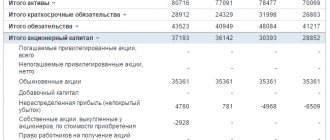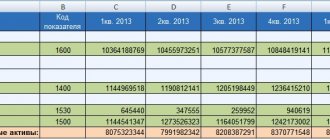Structure of the enterprise's equity capital
Equity capital can be defined as a complex of sources of financing the company’s activities in the amount of funds provided by its owners, as well as those generated in the process of core activities. It includes:
- authorized capital and its analogues;
- additional;
- spare;
- repurchased shares;
- profit after distribution.
The number of interpretations of the term “equity capital” is quite significant, but the greatest practical value from the point of view of accounting procedures is to consider it as a set of elements from the above list. A similar approach is given in paragraph 66 of Order No. 34n of the Ministry of Finance of the Russian Federation dated July 29, 1998, which regulates the procedure for preparing financial statements. Based on the above, the methodology for accounting for equity capital can be presented in the form of accounting for each component separately.
The authorized capital as an integral element of the company's capital
The basis of a company's own funds can be called the company's authorized capital. The main tasks solved by the company with its help are:
- implementation of primary investments - purchase of fixed assets, intangible assets, materials, raw materials, goods, etc.;
- creating a kind of safety net that guarantees the fulfillment of the company’s obligations under contracts, including credit agreements;
- the opportunity for the owners of the company to influence the way the business is conducted through shares in ownership.
To record all movements of the authorized capital in the registers, account 80 “Authorized capital” is used, which was put into effect by order of the Ministry of Finance of the Russian Federation dated October 31, 2000 No. 94n. It is classified as passive, an increase in its size is reflected as a credit, and a decrease as a debit. Quite often it is used in conjunction with an account for accounting for settlements with founders (75).
Accounting for authorized (share) capital (fund)
It was previously noted (see Fig. 2.2) that the sources of property formation are own funds (equity capital) and borrowed funds (borrowed capital).
Equity
consists of authorized capital, additional capital, reserve capital, special purpose funds and retained earnings.
Currently, to characterize that part of the equity capital, the size of which is indicated in the constituent documents, the concepts of “authorized capital”, “share capital”, “authorized fund”, “mutual fund” are used.
Authorized capital
represents the totality in monetary terms of contributions (shares, shares at par value) of the founders (participants) to the property of the organization upon its creation to ensure activities in the amounts determined by the constituent documents.
Share capital
- this is the totality of contributions of participants in a general partnership or limited partnership made to the partnership for the implementation of its economic activities.
State and municipal unitary organizations, instead of authorized and share capital, form, in the prescribed manner, an authorized fund - a set of fixed and working capital allocated to the organization by the state or municipal bodies.
Unit trust
- this is the totality of share contributions of members of a production cooperative for joint business activities, as well as the value of property acquired and created in the process of activity.
Accounting for authorized and share capital, authorized and share funds is carried out on passive account 80 “Authorized capital”. The balance of this account must correspond to the size of the authorized capital (fund) recorded in the constituent documents of the organization.
After state registration of an organization created with funds from the founders, the authorized capital in the amount provided for by the constituent documents is reflected in the credit of account 80 “Authorized capital” in correspondence with account 75 “Settlements with founders”. The actual receipt of deposits of the founders is carried out on the credit of account 75 to the debit of the accounts:
- 08 “Investments in non-current assets” - for the value of buildings, structures, machinery and equipment and other property related to fixed assets contributed to deposits;
- 08 “Investments in non-current assets” - for the value of intangible assets added to the deposit account, i.e. rights arising from copyright and other contracts for works of science, computer programs, databases, patents for inventions, etc. Received fixed assets and intangible assets are written off from account 08 to accounts 01 “Fixed Assets” and 04 “Intangible Assets” ;
- production inventories (accounts 10, 11, etc.) - for the cost of raw materials, materials and other material assets related to working capital contributed to the deposit account;
- cash (accounts 50, 51, 52, etc.) - for the amount of cash in domestic and foreign currency contributed by participants;
- other accounts - for the value of other property contributed to the deposit account.
Tangible assets and intangible assets contributed to contributions to the authorized capital are valued at the value agreed upon between the founders, based on real market prices. Securities and other financial assets are also valued at agreed values.
Currency and foreign currency assets are valued at the official exchange rate of the Central Bank of the Russian Federation in effect at the time of payment of these assets.
The assessment of currency and currency values and other property contributed as contributions to the authorized capital may differ from their assessment in the constituent documents. The difference arising in this case is written off to account 83 “Additional capital”.
Contributions in foreign currency to the authorized capital are reflected in accounting as follows.
For the amount of debt of the foreign founder:
Debit of account 75 “Settlements with founders” Credit of account 80 “Authorized capital”.
On receipts from a foreign founder of funds:
Debit of account 52 “Currency accounts” Credit of account 75 “Settlements with founders”.
For the amount of positive exchange rate difference:
Debit of account 75 “Settlements with founders” Credit of account 83 “Additional capital”.
For the amount of negative exchange rate difference:
Debit of account 83 “Additional capital” Credit of account 75 “Settlements with founders”.
This procedure for writing off differences in prices and exchange rate valuation allows you not to change the share of the founders in the authorized capital specified in the constituent documents.
Property transferred for the use and management of an organization, the ownership of which remains with shareholders and investors, is assessed by the amount of rent for the transferred property, calculated for the entire period of use of this property in the organization, but not more than the period of its existence.
An increase or decrease in the authorized capital of an organization can be carried out only by decision of the founders after making appropriate changes to the organization’s charter and other constituent documents.
When increasing the authorized capital, account 80 “Authorized capital” is credited and the accounts for accounting for sources of increasing the authorized capital are debited:
- 83 “Additional capital” - the amount of additional capital allocated to increase the authorized capital;
- 84 “Retained earnings (uncovered loss)” - for the amount of retained earnings used to increase the authorized capital;
- 75 “Settlements with founders” - for the amount of issue of additional shares;
- other accounts of sources of increase in authorized capital.
When the authorized capital is reduced, account 80 “Authorized capital” is debited and the accounts of those accounting objects to which the corresponding part of the authorized capital is written off are credited:
- 75 “Settlements with founders” - for the amount of deposits returned to the founders;
- 81 “Own shares (shares)” - at the par value of the canceled shares;
- 84 “Retained earnings (uncovered loss)” - when bringing the amount of the authorized capital to the value of net assets;
- Other accounts.
Analytical accounting for account 80 should provide information on the founders of the organization, stages of capital formation and types of shares.
How is analytical accounting of authorized capital carried out?
When accounting for equity , quite often they use various sub-accounts for account 80. So, you can open:
- subaccount 01 - to reflect the amounts of movement of funds of the authorized capital;
- subaccount 02 - for recording information about the cost of subscribed shares;
- subaccount 03 - for accumulating data on funds provided as owner contributions.
It is also possible to open sub-accounts for account 75 if necessary. Settlements with the founders to increase the authorized capital can be shown using account 75.01, for example: Dt 75.01 Kt 80.01.
How to reflect on the accounts the increase in the volume of authorized capital
As options for replenishing the authorized capital, in addition to directly depositing money, investment of various types of property and property rights at an agreed value can be used.
When material assets in any form act as a contribution, they are reflected in the accounting accounts by posting Dt 10, 08, 41 Kt 75.01.
One of the sources for increasing the size of the authorized capital is to attract funds from third-party investors, by placing securities or concluding agreements on investing fixed amounts. Such transactions are recorded in accounting using the entry Dt 75.01 Kt 80.
Often, the profit remaining after distribution is used as a source for replenishing the authorized capital. Then you need to reflect this operation in the registers as follows: Dt 84 Kt 80.
Reducing the size of the authorized capital - accounting entries
In business practice, there are often cases when the size of the authorized capital is reduced. The reasons for this may be, for example, the sale of shares of one of the owners. For such facts, the entry Dt 80 Kt 75 is used in the accounting registers for the amount of reduction in the authorized capital upon the withdrawal of participants.
Posting to the debit of account 75 can occur in correspondence with account 91 or 51 in a situation where it is planned to exclude some material assets or property from the authorized capital.
Accounting of authorized capital
The very first entry that is reflected in the accounting of a newly created company is the formation of the authorized capital: debit 75 – credit 80. The amount for this entry must correspond to the size of the charter capital stated in the charter. The balance of account 80 will remain unchanged, of course, unless the company decides to change the size of its own authorized capital, for example, does not attract new founders to its composition with an increase in the amount of the authorized capital. The debit of the 75th account reflects the debt for payment of the authorized capital by the founders. In most cases, the owners of the organization pay off this debt in cash, however, if this is allowed by the charter, you can pay for the share in the company’s management company with property. Thus, the debt of the founders is repaid by the corresponding entry on the credit of account 75 in correspondence with the debit of such accounts as 50 “Cash”, 51 “Current account”, 08 “Investments in non-current assets”, 10 “Materials”, and so on.
Analytical accounting of the authorized capital in this case will consist of detailed information on account 80: the composition of the founders, possible changes in the authorized capital, the dates on which these events took place.
Structure of accounts to reflect the movement of additional capital in the accounts
The following cases are legally approved, upon the occurrence of which there is a movement of funds associated with a change in additional capital:
- revision of the valuation of non-current and intangible assets;
- excess of the market value of shares over their par value;
- additional budget allocations from budgetary institutions.
Another case of growth of additional capital may be a revaluation of the authorized capital recorded in the constituent documents in foreign currency. For example, if it is fully or partially issued in euros and there is a significant jump in the exchange rate, the entire resulting increase must be attributed to additional capital.
In accounting, account 83 is used to account for additional capital.
It is allowed to open the following sub-accounts for it:
- 01 - to reflect the amounts of revaluation of non-current assets accounted for as additional capital;
- 02 - the amount of income received as the difference between the market and par value of shares;
- 03 - for other cases that could lead to a change in the amount of additional capital.
However, in Form No. 1 of the financial statements, the amounts for each of the specified options for the formation of an additional fund must be reflected separately. It must be remembered that virtually all of them, one way or another, fall into one account 83. This feature of accounting for the additional fund must be considered separately and kept in mind when preparing reporting forms.
Double entry procedure for additional capital
So, an increase in the amount of additional capital is recorded in accounting by the following entries:
- Dt 01 Kt 83 - increase in the value of fixed assets as a result of revaluation.
- In the event of the formation of amounts as a result of the placement of securities, several entries must be made at once:
- Dt 51 Kt 75.01 - for the par value of the issued shares upon their sale;
- Dt 75.01 Kt 83 - increase in the volume of additional capital due to an increase in the value of securities.
In addition to the above situations, as a result of which the volume of additional capital increases, there may be cases when its size decreases. When they occur, the following account entries are created:
- Dt 83 Kt 01 - in case of a “reverse” decrease in the value of non-current assets after revaluation;
- Dt 83 Kt 80 - transfer of amounts of additional capital to the authorized capital;
- Dt 83 Kt 75 - a reflection of the amounts distributed among the founders upon liquidation of the company.
Accounting for additional capital
Additional capital, unlike authorized capital, is not divided into shares contributed by specific participants - it shows the common ownership of all participants.
Additional capital consists of:
- share premium arising from the sale of shares at a price that exceeds their nominal value, and additional issue of shares;
- increase in property value due to revaluation;
- exchange rate differences arising when the founders made contributions to the authorized capital of the organization.
Additional capital is accounted for in passive account 83 “Additional capital”. The following subaccounts can be opened for this account:
- “Increase in property value due to revaluation”;
- "Share premium";
- “Exchange differences”, etc.
When property is revalued, its value may increase or decrease. An increase in the value of fixed assets during the revaluation of non-current assets is reflected in the debit of account 01 “Fixed assets” and the credit of account 83 “Additional capital”. A decrease in the value of fixed assets during revaluation carried out at the expense of additional capital is reflected in the debit of account 83 and the credit of property accounting accounts (01).
The share premium received by the organization is reflected in the debit of property accounting accounts (accounts 50 “Cash”, 51 “Settlement accounts”, 52 “Currency accounts”, etc.) and the credit of account 83.
Additional capital funds can be used for:
- increase in the authorized capital (debit account 83 and credit account 80 “Authorized capital”);
- repayment of the decrease in the value of non-current assets revealed as a result of their revaluation (account 83 is debited, non-current assets accounts are credited);
- distribution among the founders of the organization (debit of account 83, credit of account 75 “Settlements with founders”), etc.
Analytical accounting for account 83 is organized in such a way as to provide information on sources of education and areas of use of funds.
Composition of the reserve fund and features of its accounting
The reserve fund is created as a guarantor of the fulfillment of the company’s contractual obligations, as well as to compensate for possible losses of the company. As a rule, these are the main tasks that are supposed to be solved with its help, and they are reflected in the constituent documents of the organization. The basis for creating a fund is profit after distribution and investment by company participants (owners).
To account for reserve capital, passive account 82 is used. In the course of the company’s activities, the following accounting entries are generated using it:
- Dt 84 Kt 82 - for the amount of contributions to the reserve fund from profit;
- Dt 75 Kt 82 - when replenishing the fund through financial “infusions” of the owners.
In circumstances requiring the use of resources accumulated in it, the following entries are made:
- Dt 82 Kt 84 - coverage of losses;
- Dt 82 Kt 66 - allocation of amounts to repay the company's bonds and repurchase shares in the absence of other funds.
Accounting for reserve capital
In addition to the authorized capital, equity capital includes reserve and additional capital, retained earnings and targeted financing.
Reserve capital is created without fail by joint-stock companies and joint organizations in accordance with current legislation. Other organizations can create it at their discretion.
The reserve capital of a joint stock company is intended to cover its losses, as well as to repay the company's bonds and repurchase the company's shares in the absence of other funds. Reserve capital cannot be used for other purposes.
The amount of reserve capital is determined by the organization's charter. In joint stock companies it cannot be less than 15%, and in joint ventures - 25% of the authorized capital.
Contributions to the reserve capital of joint stock companies and joint ventures within the specified limits (15 and 25% of the authorized capital, respectively) are made by reducing taxable profit. At the same time, the amount of contributions to reserve capital and other funds similar in purpose should not exceed 50% of the organization’s taxable profit.
The reserve capital of other organizations is created from the profits remaining at the disposal of the organization.
To obtain information about the availability and movement of reserve capital, use passive account 82 “Reserve capital”.
Contributions to reserve capital are reflected in the credit of account 82 “Reserve capital” and the debit of account 84 “Retained earnings (uncovered loss)”.
The use of reserve capital is reflected in the debit of account 82 “Reserve capital” and the credit of account 84 “Retained earnings (uncovered loss)”. In this case, the amounts allocated to cover the loss for the reporting year are written off directly to the debit of account 82 from the credit of account 84.
Amounts of reserve capital allocated to repay bonds are recorded in two accounting entries:
Debit account 82 “Reserve capital” Credit account 84 “Retained earnings (uncovered loss)”
Debit of account 66 “Settlements for short-term loans and borrowings” or 67 “Settlements for long-term loans and borrowings” Credit of account 51 “Current accounts”
Organizations that create reserve capital at their discretion can use it for various purposes, including:
- covering losses from business activities (account 84 is credited);
- payment of income on bonds and dividends on shares in the absence of profit (accounts 70 and 75 are credited);
- increase in authorized capital (account 80 is credited);
- covering various unforeseen expenses (credit expense accounts).
Unused profit as an element of replenishment of own funds
The next component that needs to be addressed when considering the accounting procedure for equity capital is retained earnings. Its level is largely an indicator of the company's performance. In the event of negative consequences of work, this indicator may take the form of an uncovered loss.
To reflect the volume of profit received after distribution of profits, passive account 84 is used. It is used by the company only at the end of the year, and is not used the rest of the time. In fact, the balance formed on the debit or credit of account 99 at the end of the period when preparing annual reports is transferred to it. Upon receipt of a positive final financial result, a posting is made Dt 99 Kt 84, if the result is negative, the entry will be: Dt 84 Kt 99.
Retained earnings are the main source of additional financing for activities
The issue of reflecting entries in accounting accounts regarding the use of retained earnings as a source of financing for various areas of the company’s work requires more detailed study.
In particular, retained earnings can be used to pay dividends to company participants: Dt 84 Kt 75.
In addition, under favorable conditions, it can be used to pay additional remuneration to employees, such as a year-end bonus or a one-time bonus. In this case, the entry Dt 84 Kt 70 is made.
In addition, another area in which the company's profit after distribution can be used is to cover losses incurred in previous periods. However, the difficulty here lies in the need to use the same account - 84 - to reflect such operations. This problem is solved by introducing separate analytical sub-accounts. Let's say 84.01 - “Profit to be distributed”, 84.02 - “Loss to be covered”. Then the loss coverage for the reporting year will look like this: Dt 84.01 Kt 84.02.
Retained earnings as a source of business financing
Let's consider how accounting is carried out for transactions that reflect the practical use of such a component of the insurance system as retained earnings.
This financial resource can be used, for example, to pay dividends. This operation corresponds to the wiring: Dt 84 Kt 75.
Another option for using retained earnings is to pay the company’s employees. When carrying out the relevant transactions, it is necessary to use the posting: Dt 84 Kt 70.
Retained earnings can be used as a resource to cover losses recorded in previous years of business. In this case, the transaction is carried out within the same account - 84, and therefore, in order to correctly reflect this operation, the accountant needs to open a number of additional sub-accounts. For example, 84.01, which records retained earnings or losses from previous years, as well as 84.02, which reflects current retained earnings. The posting recording the coverage of losses may look like this: Dt 84.02 Kt 84.01.
Peculiarities of accounting for the repurchase of owners' shares in capital
A separate element included in the company’s own funds are operations to buy out the shares of the company’s co-owners. Such facts must be reflected in the debit of account 81 in the amount of amounts actually paid and the credit of accounts corresponding to the payment option (for example, 51 - when paying through a current account, 50 - through the company's cash desk in cash): Dt 81 Kt 51, 50.
There are options that require making entries on the credit of account 81. For example, if the authorized capital is subject to reduction by the amount of the par value of the company's shares, an entry is made Dt 80 Kt 81.
Accounting for own shares (shares) purchased by the company
Joint-stock companies can buy back shares from shareholders for the purpose of their subsequent resale, cancellation or distribution among their employees. Shares purchased from shareholders are accounted for in account 81 “Own shares (shares)”. The cost of repurchased shares is reflected in the debit of account 81 and the credit of cash accounting accounts.
In accordance with the Methodological Recommendations on the procedure for forming indicators of financial statements of organizations (36), own shares purchased from shareholders should be accounted for by the amount of actual costs. Previously, they were accepted for accounting at face value.
Repurchased shares do not provide voting rights at shareholder meetings, and dividends are not accrued or paid on them. They can be reflected on the organization’s balance sheet up to one year after their redemption.
When resale of shares, they are written off from the credit of account 81 to the debit of the cash accounting accounts. Canceled shares are written off to reduce the authorized capital (debit to account 80, credit to account 81).
The difference in the cost of sold and canceled shares is written off to account 91 “Other income and expenses”:
- for expenses - debit account 91, credit account 81;
- for income - debit account 81, credit account 91.
Equity as part of the balance sheet
When organizing accounting for an organization's equity capital, it is necessary to take into account the specifics of using this information in financial statements. It was noted above that all equity capital is divided into authorized, additional, reserve, retained earnings, and the amount of shares purchased from the co-owner.
It is this structure that is reflected in the third section of the balance sheet, approved by order of the Ministry of Finance of the Russian Federation dated July 2, 2010 No. 66n. Based on the balance sheet, the company's total equity can be calculated by adding the following lines:
- 1310 - authorized capital;
- 1320 - size of purchased shares;
- 1340 and 1350 - components of additional capital;
- 1360 - reserve fund;
- 1370 - retained earnings.
Data in the balance sheet on lines 1310, 1320, 1360 and 1370 are determined based on the balances of accounts 80 (credit), 81 (debit), 82 (credit) and 84 (depending on the final financial result of the debit or credit) respectively.
Some difficulties may arise when preparing lines 1340 and 1350 in Form No. 1. The first reflects the results of the revaluation of non-current assets, the second - additional capital formed from other sources. Although the revaluation of fixed assets is by definition included in the additional fund, legislators require it to be taken into account separately in the balance sheet.
At the same time, this accounting option does not create any insoluble difficulties, since for these purposes a separate subaccount is applied to account 83 “Additional capital”. To determine the amount that needs to be entered into line 1350, you need to subtract the data from the subaccount that takes into account the results of the revaluation from the total final balance of account 83.
The total amount of equity is determined in the balance sheet on page 1300 by adding all the lines of section 3.
***
Correct accounting of an enterprise's equity capital presupposes knowledge of its structure and the features of how all its constituent elements are reflected in the accounts. When accounting, it is necessary to separately record the authorized, additional, reserve capital, the amount of repurchased shares and retained earnings. In particular, additional capital, due to the specifics of its formation from different sources, requires separate accounting for each of them. For these purposes, it is necessary to open specialized analytical sub-accounts for most accounts intended for accumulating information on changes in capital.
Retained earnings, in addition to increasing the amount of equity capital, can be used to cover losses of both current and previous periods. In this case, postings are made within one account 84, but using different subaccounts.
Of no small importance is the correct reflection of data on the state of capital in the balance sheet. For these purposes, data based on the results of the accounts of their components at the end of the period are used. In this case, additional capital is also reflected in two parts: formed through the revaluation of non-current assets and from other possible sources. Thus, knowing all the nuances listed above, a specialist will easily reflect the movement of equity capital on the accounting accounts and provide reliable information to all interested users of the statements.
Similar articles
- Accounting for equity
- The procedure for forming additional capital
- Ways to increase net assets by founders
- Own capital - what is this line on the balance sheet?
- Statement of changes in capital - sample filling
Concept of equity
Capital is the basis for the creation and development of an organization.
In the course of the company’s economic activities, he ensures the interests of staff, owners and the state. Each company has a certain capital, which represents the totality of cash and other funds necessary for the implementation of business activities. Depending on the ownership of a particular organization, funds are divided into own or borrowed (Fig. 1). Own capital is the source of the formation of the company's property and belongs to the liability side of the balance sheet.
Definition 1
Equity capital is formed from the funds of the organization's owners. Equity is the value of all the company's funds owned by it and used to form a share of assets. With this capital, a business entity can operate without any obstacles when making transactions. The amount of equity capital depends on the financial performance of the company. The profit received accordingly increases equity capital, and the loss decreases. The amount of equity is defined as the difference between the value of all assets of the organization and its liabilities.
Finished works on a similar topic
- Course work Accounting for equity capital 410 rub.
- Abstract Accounting for equity capital 260 rub.
- Test work Accounting for equity capital 240 rub.
Receive completed work or specialist advice on your educational project Find out the cost
Own capital is formed and replenished from the following sources:
- funds (money or property) invested by the owners of the organization during its establishment (authorized capital, share capital, authorized capital);
- net profit of previous years and the reporting year minus income paid from it and dividends to the founders;
- gratuitous contributions from founders or other individuals and legal entities;
- targeted financing invested on an irrevocable basis.
Example 1
Authorized capital and net profit are the main sources of equity capital formation. The increase in the organization's equity capital is ensured by successful financial and economic activities, due to the net profit of the reporting years.
The company's own capital has the following components (Fig. 1):
- authorized capital (share capital, authorized capital);
- Extra capital;
- reserve capital, other reserves;
- retained earnings.
Do you need to select material for your study work? Ask a question to the teacher and get an answer in 15 minutes! Ask a Question
Picture 1.
The amount of the authorized capital is indicated in the charter or constituent documents. This amount can only be changed in accordance with the results of the enterprise’s activities over the past year and as a result of changes in data in the company’s constituent documents. The share capital (authorized capital, authorized fund) of an organization indicates the minimum amount of the company's property, which guarantees the interests of creditors. Own funds should not be less than the declared authorized capital.
Equity capital is a source of funds that are used by an organization to achieve various goals.
Own funds have two main components: capital invested by the owners in the enterprise, that is, invested, and capital created in addition to what was initially advanced by the owners, that is, accumulated. Invested funds are formed by preferred and common shares. Additional paid capital and funds received free of charge are also included. Accumulated funds are formed in the process of distributing the net profit of the enterprise. Thus, equity capital, such as the equity capital of a bank or trading company, will vary depending on the performance of the firm.
If the organization has no obligations to creditors, i.e. accounts payable, then the value of the total property (assets) of the organization is equal to the amount of equity capital. If the organization has liabilities, then its equity capital will be equal to the amount of assets minus the amount of liabilities. Therefore, the amount of equity capital is also called net assets. The value of the enterprise's net assets is assessed in a certain order, the basis of which is the data of the annual balance sheet.







